Daily Current Affairs for UPSC 18th Oct 2025



| Index |
| S.No | Topic | Page No |
| Daily Hindu Analysis (YouTube) |
| 1. | Better global governance, led by China and India |
|
| 2. | The next steps for Afghanistan after the New Delhi visit |
|
| 3. | Russia backs AMCA, offers to make Su-57 jets in India |
|
| 4. | Rotavirus vaccine effective against gastroenteritis in children: study |
|
| 5. | SC quashes FIRs under U.P. Act on conversion, says law not tool to harass innocents |
|
| 6. | Nashik unit open; HAL can roll out 24 Tejas jets a year |
|
| Daily Current Affairs (App) |
| 7. | Public trust doctrine applies to man-made waterbodies too, says Supreme Court |
|
| 8. | UIDAI launches ‘Scheme for Innovation and Technology Association with Aadhaar (SITAA)’ |
|
| 9. | Chhattisgarh Successfully Reintroduces Blackbuck into State Forests |
|
| 10. | India and Brazil to Expand Trade Agreement with MERCOSUR Bloc |
|
Better global governance, led by China and India
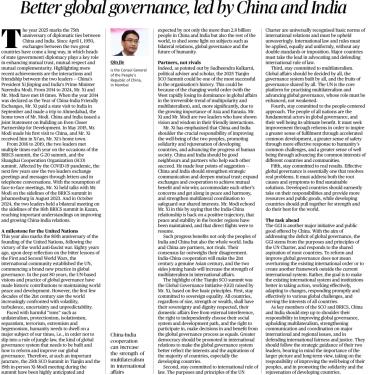
Syllabus Mapping
- GS Paper 2:
- International Relations: Bilateral, regional, and global groupings.
- Effect of policies of developed and developing countries on India’s interests.
- Important International Institutions, agencies, and forums — their structure and mandate.
Context The year 2025 marks 75 years of diplomatic relations between India and China, a milestone that comes at a time of global transformation marked by multipolarity, geopolitical shifts, and calls for reformed multilateralism.
The article, written by Qin Jie, Consul General of the People’s Republic of China in Mumbai, emphasizes the potential for India and China to jointly lead reforms in global governance, promote equitable development, and strengthen the role of developing countries in the international system.
Background: 75 Years of India–China Relations - Diplomatic ties between India and China were established on April 1, 1950, when India became one of the first non-communist nations to recognize the People’s Republic of China (PRC).
- Over the decades, the relationship has seen phases of cooperation, conflict, and cautious engagement.
- From 2014 to 2024, Prime Minister Narendra Modi and President Xi Jinping met 18 times, reflecting both diplomatic continuity and strategic complexity.
- Despite border tensions, both countries remain committed to dialogue through mechanisms such as the BRICS, Shanghai Cooperation Organisation (SCO), and G20.
Current Relevance The article calls for India and China to work together on issues of global governance, reformed multilateralism, and sustainable development, especially as the world transitions from Western-dominated global order to a multipolar world centered on Asia. Both nations, as civilizational powers and emerging economies, share the responsibility of shaping a fairer international order that reflects the aspirations of the Global South.
Key Arguments in the Article
1. Shared Responsibility for Global Progress
- India and China, home to over 2.8 billion people, hold immense potential to influence global policy.
- Both nations can jointly work to enhance the well-being of developing countries, promote inclusive growth, and strengthen South-South cooperation.
2. Strengthening Bilateral Relations - The article emphasizes the need to:
- Strengthen strategic communication and deepen mutual trust.
- Expand cooperation in trade, technology, and sustainable development.
- Promote mutual benefit through peaceful coexistence and dialogue.
- A stable India-China relationship will have positive spillover effects on regional and global stability.
3. Reforming Global Institutions - The author highlights that current global governance frameworks—especially the United Nations, IMF, and World Bank—do not adequately represent the voices of developing nations.
- India and China, as major developing economies, should push for:
- Reformed multilateralism,
- Enhanced representation of the Global South, and
- A development-centric international order rather than one dominated by military or geopolitical interests.
4. Guiding Principles for a New Global Order Mr. Xi Jinping’s five-point agenda for future cooperation: 1. Strengthen communication and deepen trust.
2. Expand cooperation and pursue win-win outcomes.
3. Accommodate each other’s concerns and maintain regional peace.
4. Strengthen multilateral coordination to safeguard shared interests.
5. Promote equitable global governance reflecting inclusivity and mutual respect.
5. Multilateralism and the Role of the UN
- The article calls for defending the UN-centered international order, particularly against unilateralism, protectionism, and bloc-based politics.
- Major countries like India and China must uphold the principles of the UN Charter, promote international law, and reject hegemonic dominance.
Broader Analysis India-China Complementarity - Despite strategic differences (border disputes, Indo-Pacific alignment), both nations share economic and developmental complementarities:
- Leading members of BRICS, SCO, and G20.
- Advocates of multilateralism and South-South cooperation.
- Shared interest in climate action, digital economy, and AI governance.
Global Governance in Transition - The global system is witnessing a decline of Western dominance and a rise of multipolarity.
- Institutions created post–World War II (UN, IMF, World Bank) need reform to represent emerging powers.
- India and China, if they cooperate constructively, could become joint anchors of a new global governance architecture based on equality and shared prosperity.
Challenges Ahead - Border disputes (Ladakh, Arunachal Pradesh) and strategic mistrust remain major hurdles.
- India’s growing alignment with the U.S. and Quad contrasts with China’s rivalry with Western powers.
- The success of a joint Indo-China leadership in global governance will depend on their ability to compartmentalize bilateral disputes while cooperating on global issues.
Relevance for India - Reinforces India’s role as a responsible stakeholder in shaping global institutions.
- Supports India’s vision of reformed multilateralism — expansion of UNSC to include India and other developing powers.
- Aligns with India’s leadership of the Global South under platforms like Voice of Global South Summit (2023).
UPSC Mains Q:
“India and China, despite being strategic rivals, share complementary roles in shaping the 21st-century global governance architecture.” Discuss in the context of their shared vision for reformed multilateralism and South-South cooperation.
The next steps for Afghanistan after the New Delhi visit
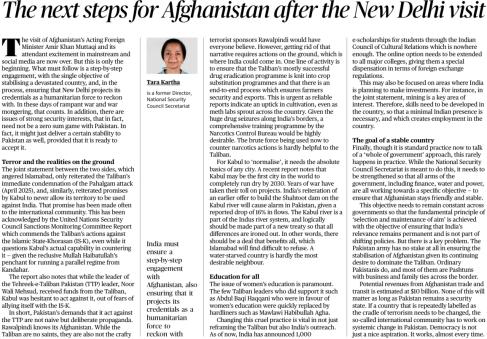
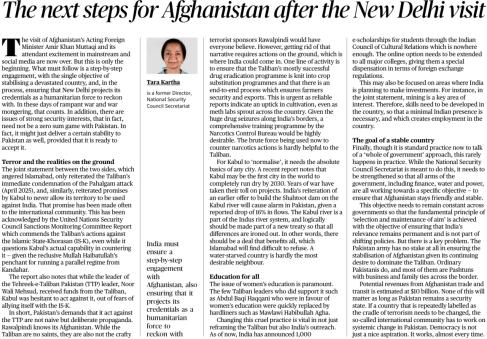
Syllabus Mapping
GS Paper 2: India and its Neighbourhood – Relations, Bilateral, regional and global groupings affecting India’s interests, Effect of policies of developed and developing countries on India’s interests, Role of International Institutions in regional stability
Context ·
Afghanistan’s Acting Foreign Minister Amir Khan Muttaqi’s visit to New Delhi marks a significant step in India’s cautious re-engagement with the Taliban regime. · The visit represents India’s humanitarian and strategic balancing approach towards a war-torn, politically unstable neighbour that still poses major security and geopolitical challenges. · The article, written by Tara Kartha, former Director of the National Security Council Secretariat, outlines how India can take a step-by-step engagement strategy to stabilise Afghanistan while protecting its own interests and preventing regional instability.
Background
- India maintained a policy of non-recognition of the Taliban regime since its takeover in August 2021, but continued humanitarian assistance such as food grains, vaccines, and medical aid through the UN World Food Programme (WFP).
- Afghanistan remains crucial to India’s strategic depth, given its geographical location linking Central and South Asia.
- India’s engagement now seeks to achieve stability in Afghanistan through development cooperation, counterterrorism coordination, and economic assistance, without legitimising extremist governance.
Core Issues Highlighted in the Article 1. Terror and Ground Realities
- The joint statement issued during Muttaqi’s visit reaffirmed:
- The Taliban’s commitment not to allow Afghan territory to be used for terrorism against India.
- India’s support for humanitarian assistance and regional stability.
- However, Pakistan expressed displeasure, as the Taliban refrained from targeting Tehreek-e-Taliban Pakistan (TTP), which operates from Afghan soil.
- The UN Security Council Sanctions Monitoring Committee acknowledges the Taliban’s limited success in countering ISIS-K but notes the presence of parallel power structures under regional warlords.
Implication for India:
A stable Afghanistan prevents spillover of extremism and drugs into India, particularly in border states. Hence, counterterror cooperation must remain central to India’s Afghan engagement.
2. Economic Engagement and Developmental Projects
- India’s long-standing development assistance in Afghanistan exceeds $3 billion, covering over 500 projects in infrastructure, health, education, and capacity building.
- India has reiterated plans to resume delayed projects like the Shahtoot Dam near Kabul, which aims to provide drinking water to the city but raises water-sharing concerns with Pakistan.
- India also proposed crop substitution programmes to replace opium cultivation with sustainable agriculture, coupled with training through the Narcotics Control Bureau (NCB).
- Promoting vocational training and e-scholarships for Afghan youth through the Indian Council for Cultural Relations (ICCR) could strengthen people-to-people ties.
Way Forward:
Focus on sectors like energy, water, and education, with a calibrated return of Indian investments that minimize risks but sustain India’s presence.
3. Women’s Education and Social Development
- The Taliban’s ban on women’s education remains one of the most regressive aspects of its governance.
- The article stresses India’s role in offering remote education, digital scholarships, and higher education opportunities through online and hybrid models.
- Such initiatives would ensure that India remains a supportive humanitarian actor without legitimizing the Taliban’s patriarchal policies.
4. Security and Regional Diplomacy - Kabul’s instability directly affects India’s national security and regional peace.
- India’s strategy should be based on “step-by-step engagement”, ensuring:
- Coordination with Iran, Central Asian Republics, and Russia to counter narcotics and terrorism.
- Avoiding zero-sum competition with Pakistan but ensuring New Delhi’s strategic autonomy.
- India can use its developmental footprint to build influence gradually while encouraging the Taliban to mainstream into regional mechanisms.
5. Institutional Coordination within India - The author calls for a whole-of-government approach, strengthening coordination between:
- The Ministry of External Affairs (MEA),
- National Security Council Secretariat (NSCS), and
- Line ministries (Education, Commerce, Agriculture, Power).
- Such coordination ensures that India’s engagement in Afghanistan remains coherent, long-term, and adaptive.
Strategic Importance for India 1. Geopolitical Leverage: Afghanistan serves as a critical buffer against Pakistani influence and Chinese expansion through the China-Pakistan Economic Corridor (CPEC).
2. Connectivity Projects: India’s interest in Chabahar Port (Iran) and International North-South Transport Corridor (INSTC) depends partly on stability in Afghanistan.
3. Counterterrorism: Afghanistan’s destabilisation could embolden extremist groups in South Asia; hence, cooperation with Kabul is necessary to prevent radical spillovers.
4. Humanitarian Diplomacy: Enhances India’s global image as a non-intrusive humanitarian power, aligning with its “Neighbourhood First” and “Security and Growth for All in the Region (SAGAR)” policies.
UPSC Mains Q: “India’s engagement with Afghanistan after the Taliban takeover must balance humanitarian assistance with strategic caution.” Discuss in light of recent diplomatic developments.
Russia backs AMCA, offers to make Su-57 jets in India
Context · Russia has reaffirmed its commitment to deepen defence cooperation with India by expressing readiness to support the Advanced Medium Combat Aircraft (AMCA) programme through local production of its Su-57 fifth-generation fighter jets. · The announcement underscores the continuing strategic defence partnership between India and Russia at a time when global geopolitics and sanctions pressure are reshaping defence supply chains.
What is AMCA?
- The Advanced Medium Combat Aircraft (AMCA) is India’s indigenous fifth-generation stealth multirole fighter jet project being developed by DRDO and Hindustan Aeronautics Limited (HAL).
- The project aims to enhance India’s self-reliance in defence manufacturing (Atmanirbhar Bharat) by reducing dependence on foreign suppliers.
- The AMCA is expected to feature stealth capabilities, advanced avionics, supercruise capability, and AI-assisted systems.
About Russia’s Offer: Local Production of Su-57 - The Su-57 is Russia’s fifth-generation multi-role fighter jet, equipped with stealth features, super-maneuverability, and advanced radar and weapon systems.
- Russia’s Ambassador Denis Alipov stated that Moscow is ready for localised production and full technology sharing for Su-57 jets under India’s AMCA framework.
- This signifies a shift from a buyer-seller relationship to joint development and co-production, in line with India’s Defence Production and Export Promotion Policy (DPEPP).
Strategic Importance for India 1. Technological Edge: Access to fifth-generation fighter technology will help India modernize its air fleet and reduce dependency on imports.
2. Make in India Push: Local production supports India’s defence indigenization goals under Atmanirbhar Bharat.
3. Strengthened Bilateral Ties: Reinforces the long-standing India-Russia strategic partnership, especially in defence, energy, and space sectors.
4. Geopolitical Balance: Comes amid Western pressure on India to diversify away from Russian defence equipment following the Ukraine conflict.
5. Diversification of Collaboration: Both sides are also exploring partnerships in anti-drone systems, advanced radar solutions, and precision-strike technologies.
UPSC Prelims Q: With reference to the Advanced Medium Combat Aircraft (AMCA) project, consider the following statements:
1. It is being developed by Hindustan Aeronautics Limited (HAL) in collaboration with the Defence Research and Development Organisation (DRDO).
2. The AMCA is designed to be a fifth-generation stealth multirole fighter aircraft.
3. The AMCA programme includes foreign collaboration under the Strategic Partnership Model (SPM). Which of the statements given above is/are correct?
(a) 1 and 2 only
(b) 2 and 3 only
(c) 1 and 3 only
(d) 1, 2, and 3
Answer: (a)
Rotavirus vaccine effective against gastroenteritis in children: study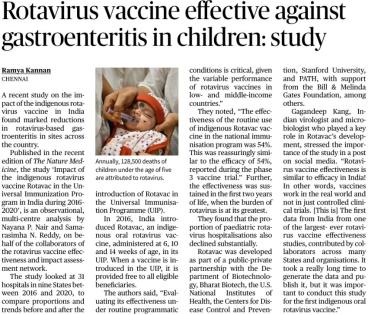
Syllabus Mapping
- GS Paper 2: Issues relating to development and management of Social Sector/Services relating to Health, Education, and Human Resources.
- GS Paper 3: Science and Technology — Developments and applications in biotechnology; Indigenization of technology and developing new technology.
Context A new multi-centre study published in
The Nature Medicine has confirmed that India’s indigenous rotavirus vaccine, Rotavac, has been highly effective in preventing rotavirus-induced gastroenteritis among children under five years of age across multiple states. The findings reaffirm the success of India’s vaccination efforts under the Universal Immunisation Programme (UIP) and highlight the effectiveness of indigenous vaccine innovation in addressing major child health challenges.
What is Rotavirus?
- Rotavirus is a highly contagious virus that causes severe diarrhoea and dehydration in infants and young children.
- It is a leading cause of gastroenteritis-related deaths globally.
- According to WHO, rotavirus causes ~128,500 child deaths annually worldwide, mostly in low- and middle-income countries.
About the Study - Conducted between 2016 and 2020 across 31 hospitals in nine Indian states.
- Evaluated the impact of the indigenous Rotavac vaccine after its introduction under the UIP.
- Found a 54% effectiveness rate — similar to the efficacy levels recorded in phase-3 clinical trials.
- The vaccine’s impact was sustained for the first two years of life, when children are most vulnerable to rotavirus infections.
- There was a significant decline in hospitalisations due to rotavirus-related diarrhoea after the introduction of Rotavac.
About Rotavac - Developed under a public–private partnership between:
- Department of Biotechnology (DBT), Government of India
- Bharat Biotech
- U.S. National Institutes of Health (NIH)
- PATH and other international collaborators
- Introduced in India’s Universal Immunisation Programme (UIP) in 2016.
- Administered orally at 6, 10, and 14 weeks of age.
- Provided free of cost to eligible beneficiaries under UIP.
Significance of Findings 1. Public Health Impact:
The results confirm that the indigenous vaccine has substantially reduced the burden of childhood diarrhoea and related hospitalisations.
2. Atmanirbhar Bharat in Healthcare:
Demonstrates India’s capacity for domestic vaccine innovation with global-level efficacy, strengthening vaccine self-reliance. 3. Evidence-Based Policy Success:
Reinforces the role of UIP and data-driven vaccination strategies in improving child survival rates. 4. Global Relevance:
Highlights how low- and middle-income countries can effectively deploy indigenous solutions to address region-specific disease challenges.
UPSC Prelims Q: With reference to the Rotavac vaccine, consider the following statements:
1. It is an indigenous oral vaccine developed under a public–private partnership.
2. It is used for the prevention of diarrhoea caused by rotavirus in children.
3. It has been introduced in the Universal Immunisation Programme (UIP) of India. Which of the statements given above is/are correct?
(a) 1 and 2 only
(b) 2 and 3 only
(c) 1 and 3 only
(d) 1, 2, and 3
Answer: (d)
SC quashes FIRs under U.P. Act on conversion, says law not tool to harass innocents

Syllabus Mapping GS Paper 2: Polity and Governance – Structure, functioning, and powers of the Judiciary, Government policies and issues arising out of their implementation, Fundamental Rights – Freedom of religion, liberty, and equality before law.
Context The Supreme Court of India has quashed multiple FIRs filed under the Uttar Pradesh Prohibition of Unlawful Conversion of Religion Act, 2021, ruling that the law cannot be used as a tool to harass innocent citizens.
The judgment underscores the importance of protecting personal liberty, preventing misuse of criminal law, and ensuring fair investigative processes in cases related to religious conversions.
Background: U.P. Prohibition of Unlawful Conversion of Religion Act, 2021 - The Act seeks to prohibit religious conversions by misrepresentation, force, undue influence, coercion, allurement, or marriage.
- It mandates prior declaration before conversion and grants police powers to investigate such cases.
- Critics argue that the law has been used to target interfaith marriages and intimidate minorities, while supporters claim it safeguards religious freedom and social order.
Supreme Court’s Key Observations 1. No Victim Complaint: o The Court noted that no victim of conversion had personally approached the police with a complaint. o FIRs were instead filed by third parties, which the Court said violated the principle of locus standi (only the aggrieved person can initiate proceedings).
2. Misuse of Law: o The Bench of Justices J.B. Pardiwala and Manoj Misra stated that criminal law cannot be weaponized to harass or intimidate individuals based on “completely incredulous material”. o Continuing such prosecutions would amount to a “travesty of justice.”
3. Procedural Irregularities: o The FIRs contained glaring procedural lapses and lacked credible evidence. o The Court noted repeated FIRs for the same alleged incident, which amounted to abuse of investigative power.
4. Protection of Personal Liberty: o The judgment reaffirmed that individual choice in matters of faith and belief is protected under Article 25 (Freedom of Religion) and Article 21 (Right to Life and Personal Liberty) of the Constitution. o The State cannot intrude into personal faith decisions without credible evidence of coercion or fraud. Significance of the Judgment
- Reaffirms the Supreme Court’s role as the guardian of fundamental rights, especially against misuse of criminal laws.
- Strengthens the principle of procedural fairness and due process in investigations.
- Emphasizes that faith and marriage are personal choices, and the State’s role must be limited to preventing genuine coercion or fraud, not moral policing.
- May serve as a precedent for examining similar “anti-conversion” laws in other states (e.g., Madhya Pradesh, Gujarat, Himachal Pradesh).
UPSC Prelims Q: With reference to the
Uttar Pradesh Prohibition of Unlawful Conversion of Religion Act, 2021, consider the following statements: 1. The Act criminalizes religious conversions done by force, fraud, or inducement. 2. The Act requires prior declaration before voluntary conversion. 3. The Supreme Court recently upheld all FIRs filed under the Act as valid. Which of the statements given above is/are correct?
(a) 1 only
(b) 1 and 2 only
(c) 2 and 3 only
(d) 1, 2, and 3
Answer: (b)
Nashik unit open; HAL can roll out 24 Tejas jets a year
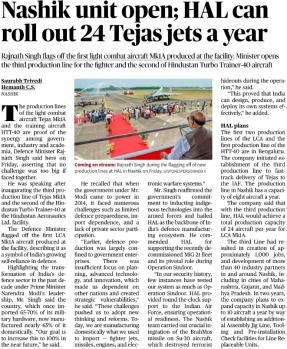
Syllabus Mapping GS Paper 3: Science and Technology — Indigenisation of technology and development of new technology, Security — Defence technology, internal security challenges, and modernisation of armed forces, Infrastructure — Role of manufacturing sector in India’s economic growth.
Context India achieved a major milestone in its journey towards defence indigenisation as Defence Minister Rajnath Singh inaugurated HAL’s new production lines at Nashik — the third line for the Light Combat Aircraft (LCA) Tejas Mk1A and the second line for the Hindustan Turbo Trainer-40 (HTT-40).
With this expansion, Hindustan Aeronautics Limited (HAL) can now produce 24 Tejas Mk1A jets per year, marking a significant boost in India’s indigenous defence manufacturing capability under the Atmanirbhar Bharat initiative.
About the Development
- The new production lines at HAL Nashik will:
- Enhance output of the LCA Tejas Mk1A to meet Indian Air Force (IAF) demands.
- Increase self-reliance in advanced fighter jet manufacturing.
- Support the production of HTT-40, the indigenously developed basic trainer aircraft.
- This development complements HAL’s existing facilities in Bengaluru, which already house:
- Two Tejas production lines, and
- One production line for the HTT-40 trainer aircraft.
Significance of Tejas Mk1A - LCA Tejas is a 4.5-generation, multi-role fighter aircraft developed by the Aeronautical Development Agency (ADA) and produced by HAL.
- It is equipped with:
- Advanced avionics,
- Active Electronically Scanned Array (AESA) radar,
- Electronic warfare systems, and
- Beyond Visual Range (BVR) missiles.
- The Tejas Mk1A variant features improved operational efficiency, reduced maintenance time, and enhanced combat capabilities over earlier versions.
Why It Matters 1. Strengthening Self-Reliance in Defence: o India now manufactures 65–70% of its defence requirements domestically, and aims to reach 100% indigenisation in key areas like aircraft, radar systems, and weapons. o The move reduces dependence on imports and strengthens strategic autonomy.
2. Boost to Employment and Industry Ecosystem: o The Nashik expansion created over 1,000 jobs directly and involved 40 industry partners across Maharashtra, Gujarat, and Madhya Pradesh. o Strengthens the defence industrial base and promotes MSME participation in high-value manufacturing.
3. Operational Readiness of IAF: o The Tejas Mk1A fleet will replace aging aircraft such as MiG-21, ensuring the IAF’s fleet modernisation. o HAL’s 24-aircraft-per-year capacity will help the IAF induct new squadrons faster and maintain optimal air strength.
4. Defence Exports and Global Outreach: o With increased production capacity, India can meet domestic defence orders and explore exports to friendly nations under Defence Diplomacy. o Tejas has already attracted interest from countries such as Argentina, Egypt, and the Philippines.
HAL’s Broader Role in Defence Manufacturing
- HAL is central to India’s indigenisation drive in aerospace and defence.
- Apart from Tejas and HTT-40, HAL is also involved in:
- Advanced Medium Combat Aircraft (AMCA) project,
- Light Utility Helicopter (LUH), and
- Upgrades of Sukhoi and Jaguar aircraft.
- HAL’s collaboration with the private sector has improved production timelines, R&D efficiency, and supply-chain integration.
Government’s Defence Vision - Atmanirbhar Bharat Abhiyan focuses on developing India as a global defence manufacturing hub.
- The Defence Acquisition Procedure (DAP) 2020 promotes Buy (Indian-IDDM) and Make in India categories.
- The government has set a target to achieve ₹1.75 lakh crore in defence production and ₹35,000 crore in defence exports by 2025.
UPSC Prelims Q: With reference to the
Light Combat Aircraft (LCA) Tejas, consider the following statements: 1. It is a multi-role fighter aircraft developed by the Aeronautical Development Agency and manufactured by HAL.
2. The Tejas Mk1A variant is equipped with an Active Electronically Scanned Array (AESA) radar and electronic warfare systems.
3. The aircraft is powered by a Russian-origin engine designed by the UAC. Which of the statements given above is/are correct?
(a) 1 and 2 only
(b) 2 and 3 only
(c) 1 and 3 only
(d) 1, 2, and 3
Answer: (a)
Public trust doctrine applies to man-made waterbodies too, says Supreme Court
Syllabus: GS Paper 2 – Polity & Governance (Judicial Doctrines; Environmental Jurisprudence)
Context: The Supreme Court held that the public trust doctrine covers not only natural waterbodies but also man-made or artificial waterbodies that serve ecological or environmental purposes.
The ruling emphasises the State’s duty to protect such resources for public use and environmental well-being.
Key Points:
- Doctrine explained: The public trust doctrine treats certain resources as held in trust by the State for public use.
- Expanded ambit: It extends to artificial waterbodies if they perform ecological/environmental functions.
- Public ownership: Resources under the doctrine are effectively owned by the public, not private individuals.
- State duty: The government must protect and maintain trust resources for the public’s benefit.
- Prohibited actions: Trust property should not be sold or alienated for private or purely industrial use.
- Permitted use: Such property must be kept available for public use and specific public purposes.
- Three restrictions: The doctrine imposes limits — public availability, no sale, and maintenance for designated uses.
- Legal roots: Originates in Roman law, developed via English common law and applied in Indian jurisprudence.
- Environmental significance: The judgment strengthens legal tools to safeguard ecological functions and urban green/blue infrastructure.
- Policy impact: Enables courts and authorities to prevent privatization or misuse of man-made waterbodies serving public/environmental roles.
Source: The Hindu
UIDAI launches ‘Scheme for Innovation and Technology Association with Aadhaar (SITAA)’
Syllabus: GS Paper 2 – Governance (E-Governance, Aadhaar, Digital Identity & Technology in Public Service Delivery)
Context: The Unique Identification Authority of India (UIDAI) has launched the Scheme for Innovation and Technology Association with Aadhaar (SITAA) to strengthen India’s digital identity ecosystem and counter emerging biometric security threats such as deepfakes, spoofing, and presentation attacks. Key Points:
- Objective: To foster collaboration between startups, academia, and industry for developing secure and scalable Aadhaar authentication technologies.
- Focus Areas: Enhancing biometric authentication, AI-driven security frameworks, and data privacy for Aadhaar.
- Innovation Platform: Aims to co-develop globally benchmarked solutions that enhance the safety and reliability of India’s digital identity infrastructure.
- Pilot Phase: Introduces three targeted innovation challenges under SITAA.
Three Targeted Challenges: 1. Face Liveness Detection:
o Development of
SDKs for active and passive face liveness detection.
o Must prevent
spoofing through photos, videos, masks, morphs, and deepfakes.
2.
Presentation Attack Detection (PAD):
o Open to
academic and research institutions to build
AI/ML-based PAD solutions.
o Should detect
print, replay, morphs, and deepfake-based attacks in real-time while ensuring
privacy compliance.
3.
Contactless Fingerprint Authentication:
o Focuses on
SDKs for fingerprint verification using smartphone cameras or low-cost imaging devices.
o Solutions must ensure
spoof detection, high-quality image capture, and
compatibility with Aadhaar’s ecosystem.
Significance: - Strengthens Aadhaar authentication resilience against digital fraud and biometric spoofing.
- Encourages domestic innovation in AI-based security and contactless biometrics.
- Aligns with India’s vision for a secure, inclusive, and future-ready digital identity framework.
Source: Press Information Bureau (PIB)
Chhattisgarh Successfully Reintroduces Blackbuck into State Forests

Syllabus: GS Paper 3 – Environment and Biodiversity (Conservation of Species, Wildlife Protection Efforts)
Context: Over the last five years, the Chhattisgarh government has successfully reintroduced the Blackbuck into the state’s forests under its five-year reintroduction plan, restoring the species to regions where it had disappeared.
Key Points:
- Species: The Blackbuck (Antilope cervicapra) is a native antelope found in India and Nepal.
- Distribution: Commonly seen across Rajasthan, Gujarat, Madhya Pradesh, Tamil Nadu, and Odisha; declared the state animal of Punjab, Haryana, and Andhra Pradesh.
- Habitat: Prefers open grasslands, dry scrub areas, and lightly forested regions.
- Distinct Features:
- Males possess long, spiraling horns (up to 20 inches).
- Males are dark brown to black, while females and juveniles are yellowish-brown.
- Noted for excellent eyesight and high running speed (up to 80 km/h).
- Social Behaviour: Lives in herds typically ranging from 5 to 50 individuals.
- Conservation Status: Listed as ‘Least Concern’ on the IUCN Red List.
- Significance of Reintroduction: Marks a successful species revival effort enhancing biodiversity and ecosystem balance in Chhattisgarh’s dryland habitats.
Source: The Indian Express (IE)
India and Brazil to Expand Trade Agreement with MERCOSUR Bloc
Syllabus: GS Paper 2 – International Relations (Regional Groupings and Trade Agreements Involving India and/or Affecting India’s Interests) Context: India and Brazil have agreed to significantly expand their existing Preferential Trade Agreement (PTA) between India and the MERCOSUR bloc, aiming to deepen trade and economic cooperation. Key Points:
- About MERCOSUR: The Southern Common Market (MERCOSUR) is a South American regional economic organization established to promote free trade and regional integration.
- Formation: Created in 1991 through the Treaty of Asunción; became a customs union in 1995.
- Objective: Ensures free movement of goods, services, capital, and people among member states.
- Members:
- Full Members: Argentina, Brazil, Paraguay, Uruguay
- Associate Members: Chile, Colombia, Ecuador, Guyana, Peru, and Suriname
- Headquarters: Montevideo, Uruguay
- Languages: Spanish and Portuguese
- Governance Structure:
- The Common Market Council is the highest decision-making body.
- Comprises foreign and economic ministers of member states.
- Presidency rotates every six months among full members.
- India–MERCOSUR Relations:
- Preferential Trade Agreement (PTA) signed in 2004 to promote bilateral trade.
- The current talks aim to expand trade coverage and enhance market access in sectors like pharma, agriculture, and manufacturing.
Source: DD News









